FIAT 500 ABARTH 2015 2.G Owner's Manual
Manufacturer: FIAT, Model Year: 2015, Model line: 500 ABARTH, Model: FIAT 500 ABARTH 2015 2.GPages: 108, PDF Size: 2.63 MB
Page 21 of 108
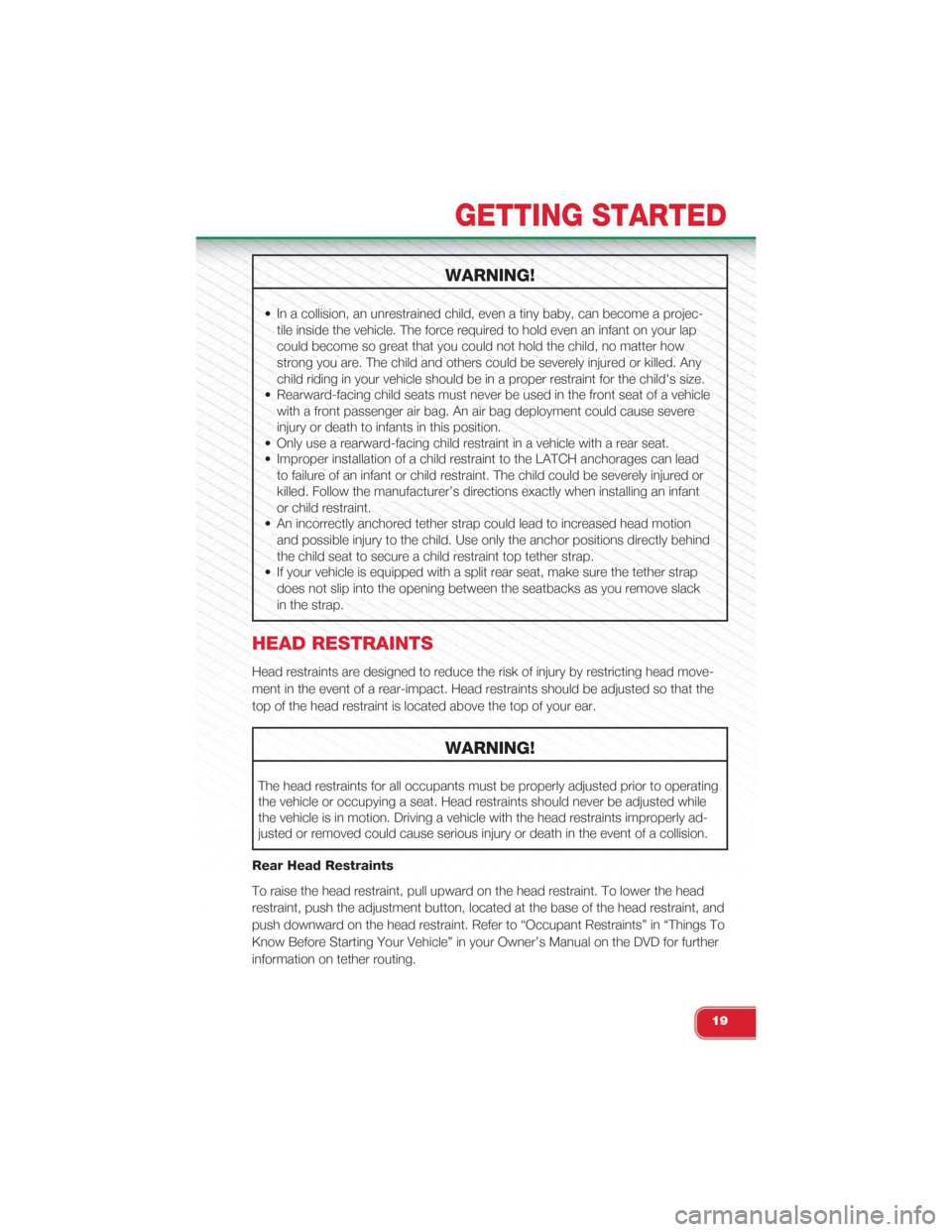
WARNING!
• In a collision, an unrestrained child, even a tiny baby, can become a projec-
tile inside the vehicle. The force required to hold even an infant on your lap
could become so great that you could not hold the child, no matter how
strong you are. The child and others could be severely injured or killed. Any
child riding in your vehicle should be in a proper restraint for the child's size.
• Rearward-facing child seats must never be used in the front seat of a vehicle
with a front passenger air bag. An air bag deployment could cause severe
injury or death to infants in this position.
• Only use a rearward-facing child restraint in a vehicle with a rear seat.
• Improper installation of a child restraint to the LATCH anchorages can lead
to failure of an infant or child restraint. The child could be severely injured or
killed. Follow the manufacturer’s directions exactly when installing an infant
or child restraint.
• An incorrectly anchored tether strap could lead to increased head motion
and possible injury to the child. Use only the anchor positions directly behind
the child seat to secure a child restraint top tether strap.
• If your vehicle is equipped with a split rear seat, make sure the tether strap
does not slip into the opening between the seatbacks as you remove slack
in the strap.
HEAD RESTRAINTS
Head restraints are designed to reduce the risk of injury by restricting head move-
ment in the event of a rear-impact. Head restraints should be adjusted so that the
top of the head restraint is located above the top of your ear.
WARNING!
The head restraints for all occupants must be properly adjusted prior to operating
the vehicle or occupying a seat. Head restraints should never be adjusted while
the vehicle is in motion. Driving a vehicle with the head restraints improperly ad-
justed or removed could cause serious injury or death in the event of a collision.
Rear Head Restraints
To raise the head restraint, pull upward on the head restraint. To lower the head
restraint, push the adjustment button, located at the base of the head restraint, and
push downward on the head restraint. Refer to “Occupant Restraints” in “Things To
Know Before Starting Your Vehicle” in your Owner’s Manual on the DVD for further
information on tether routing.
GETTING STARTED
19
Page 22 of 108

FRONT SEATS
Manual Seat Adjustment
Forward/Rearward
• Lift up on the adjusting bar, located at the front of the seat near the floor, and
release at the desired position. Then, using body pressure, move forward and
backward on the seat to be sure that the seat adjusters have latched.
Recliner
• To recline the seatback, lift up the recline lever, located on the inboard side of the
seat, lean back until the desired position has been reached, and release the lever.
Adjusting Bar
Recline Lever
GETTING STARTED
20
Page 23 of 108

Seat Height
• Drivers front seat height can be raised or lowered by using a lever, located on the
outboard side of the seat. Pump the lever upward to raise the seat height, or
pump the lever downward to lower the seat height.
EZ Entry Seats
• Pull up on the pull strap, located on
the side of the seatback, to dump the
seatback forward and slide the seat
forward. This allows for easier access
to the rear seat.
• Both front seats have a memory fea-
ture. After using the EZ Entry function,
the seat back and adjuster will re-lock
into the original position the seat was
previously adjusted to.
Seat Height Lever
EZ Entry Pull Strap
GETTING STARTED
21
Page 24 of 108
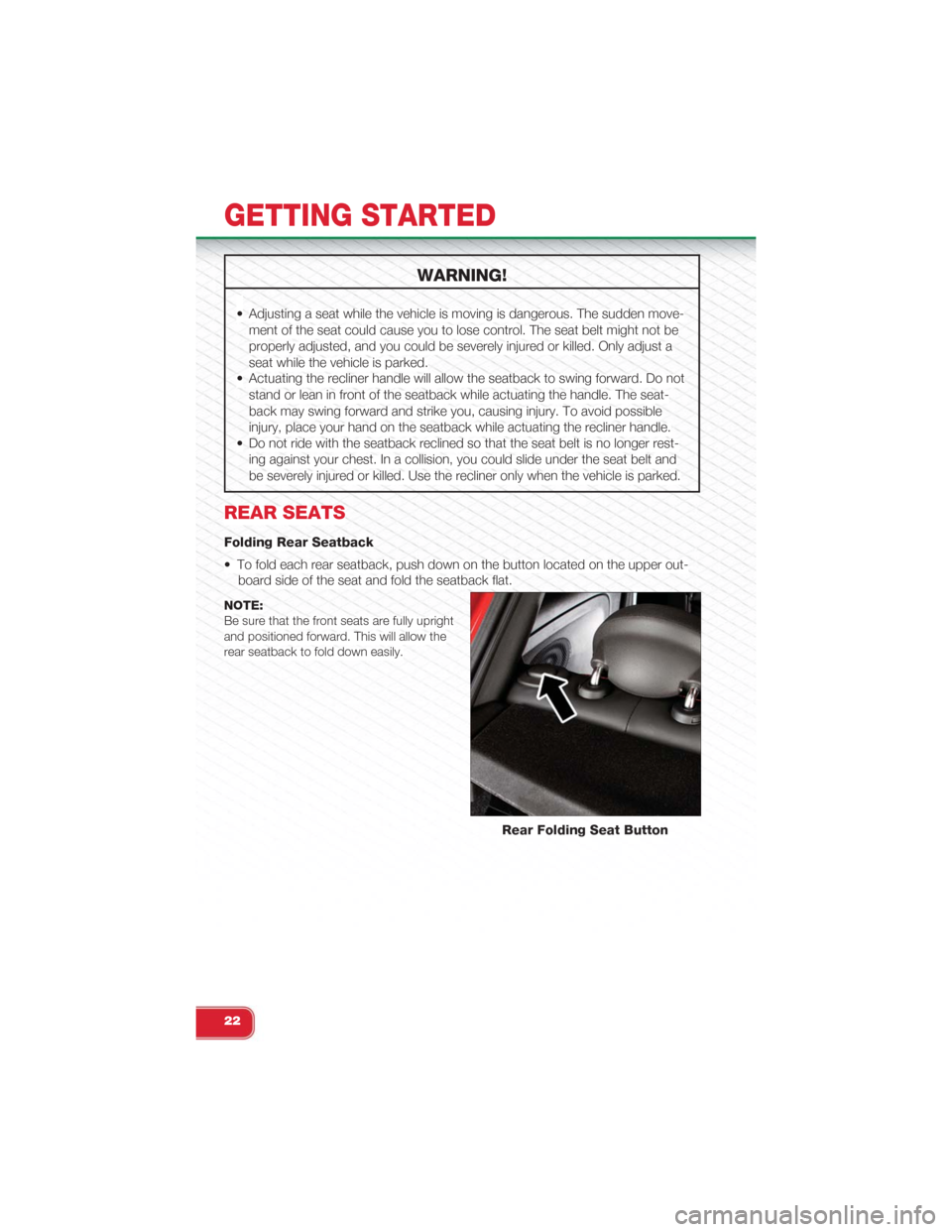
WARNING!
• Adjusting a seat while the vehicle is moving is dangerous. The sudden move-
ment of the seat could cause you to lose control. The seat belt might not be
properly adjusted, and you could be severely injured or killed. Only adjust a
seat while the vehicle is parked.
• Actuating the recliner handle will allow the seatback to swing forward. Do not
stand or lean in front of the seatback while actuating the handle. The seat-
back may swing forward and strike you, causing injury. To avoid possible
injury, place your hand on the seatback while actuating the recliner handle.
• Do not ride with the seatback reclined so that the seat belt is no longer rest-
ing against your chest. In a collision, you could slide under the seat belt and
be severely injured or killed. Use the recliner only when the vehicle is parked.
REAR SEATS
Folding Rear Seatback
• To fold each rear seatback, push down on the button located on the upper out-
board side of the seat and fold the seatback flat.
NOTE:Be sure that the front seats are fully uprightand positioned forward. This will allow therear seatback to fold down easily.
Rear Folding Seat Button
GETTING STARTED
22
Page 25 of 108
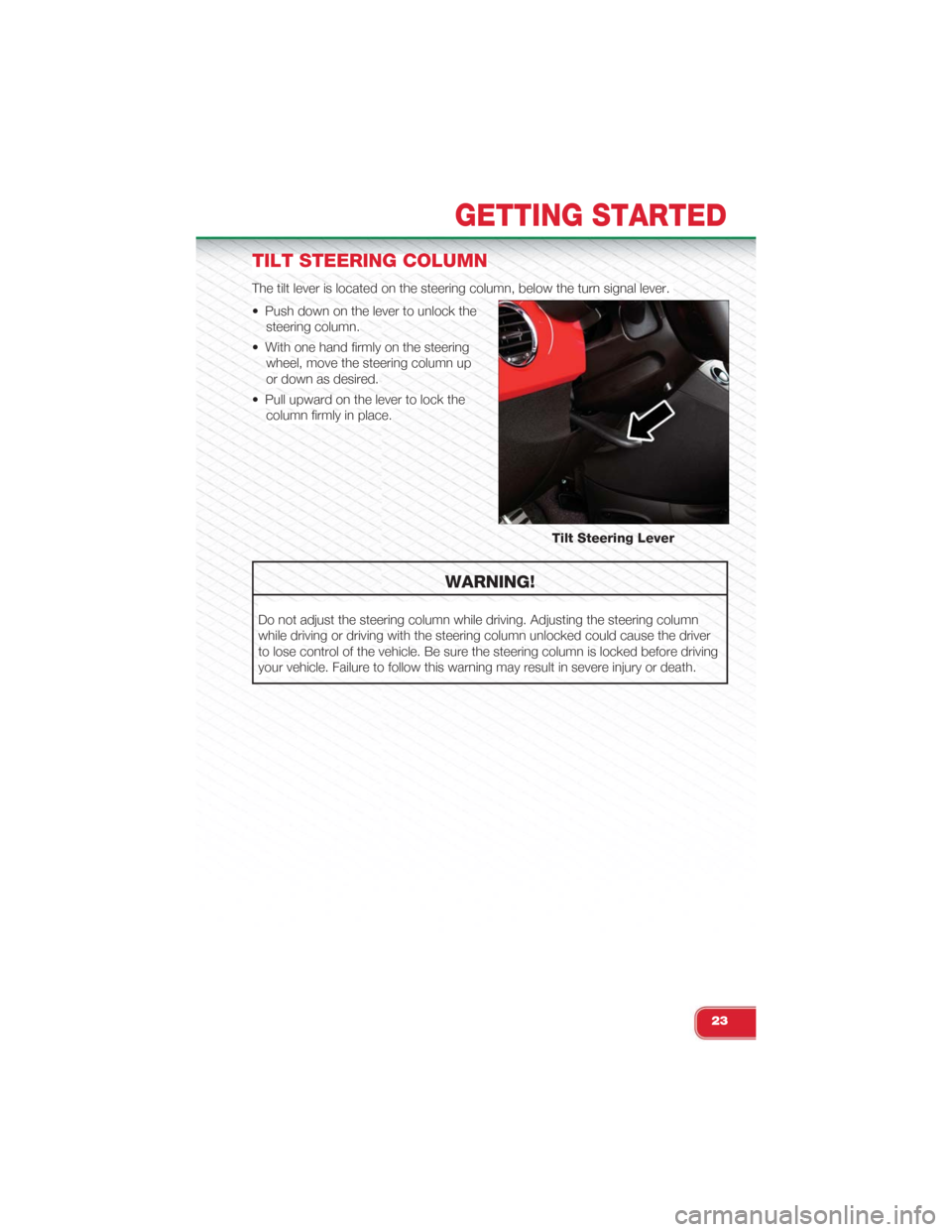
TILT STEERING COLUMN
The tilt lever is located on the steering column, below the turn signal lever.
• Push down on the lever to unlock the
steering column.
• With one hand firmly on the steering
wheel, move the steering column up
or down as desired.
• Pull upward on the lever to lock the
column firmly in place.
WARNING!
Do not adjust the steering column while driving. Adjusting the steering column
while driving or driving with the steering column unlocked could cause the driver
to lose control of the vehicle. Be sure the steering column is locked before driving
your vehicle. Failure to follow this warning may result in severe injury or death.
Tilt Steering Lever
GETTING STARTED
23
Page 26 of 108
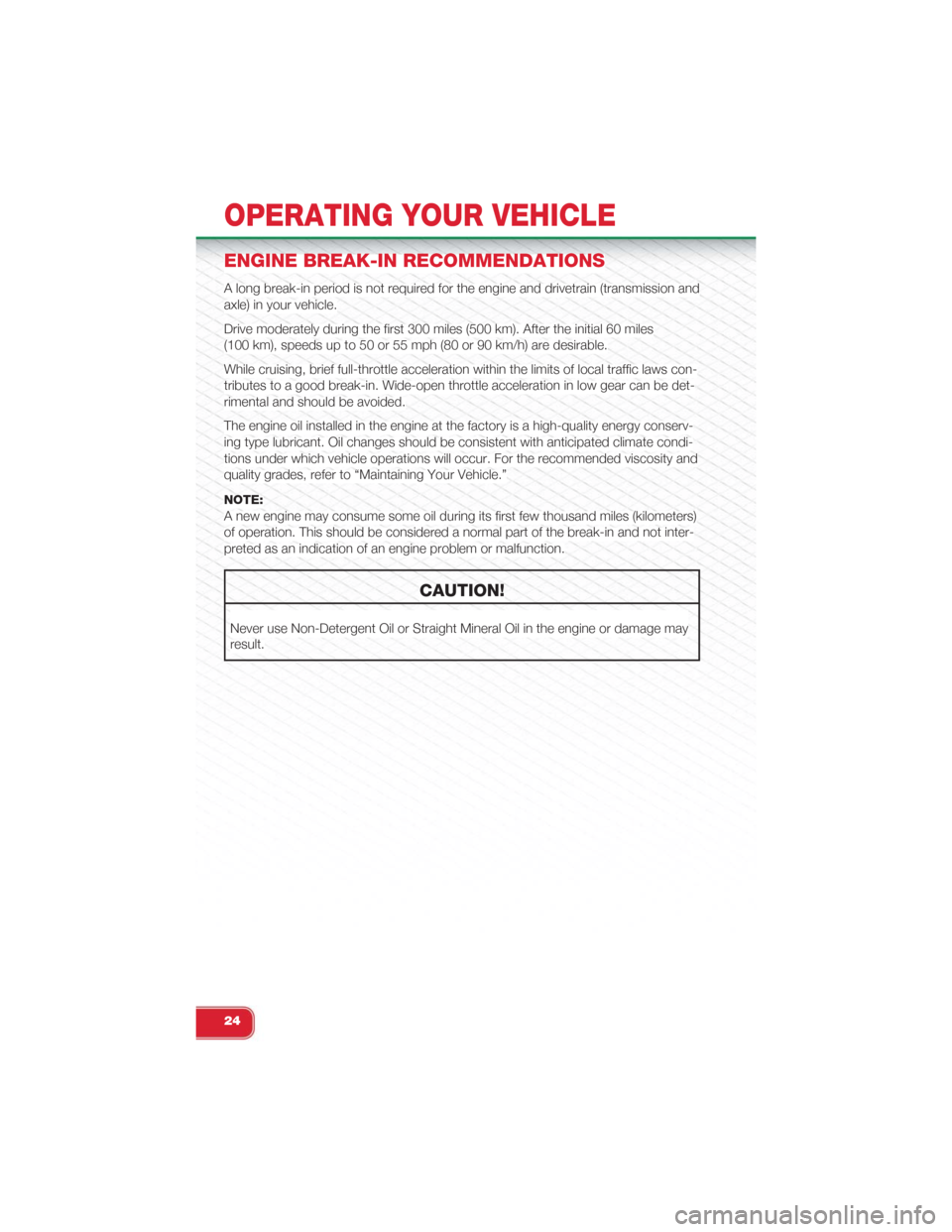
ENGINE BREAK-IN RECOMMENDATIONS
A long break-in period is not required for the engine and drivetrain (transmission and
axle) in your vehicle.
Drive moderately during the first 300 miles (500 km). After the initial 60 miles
(100 km), speeds up to 50 or 55 mph (80 or 90 km/h) are desirable.
While cruising, brief full-throttle acceleration within the limits of local traffic laws con-
tributes to a good break-in. Wide-open throttle acceleration in low gear can be det-
rimental and should be avoided.
The engine oil installed in the engine at the factory is a high-quality energy conserv-
ing type lubricant. Oil changes should be consistent with anticipated climate condi-
tions under which vehicle operations will occur. For the recommended viscosity and
quality grades, refer to “Maintaining Your Vehicle.”
NOTE:
A new engine may consume some oil during its first few thousand miles (kilometers)
of operation. This should be considered a normal part of the break-in and not inter-
preted as an indication of an engine problem or malfunction.
CAUTION!
Never use Non-Detergent Oil or Straight Mineral Oil in the engine or damage may
result.
OPERATING YOUR VEHICLE
24
Page 27 of 108
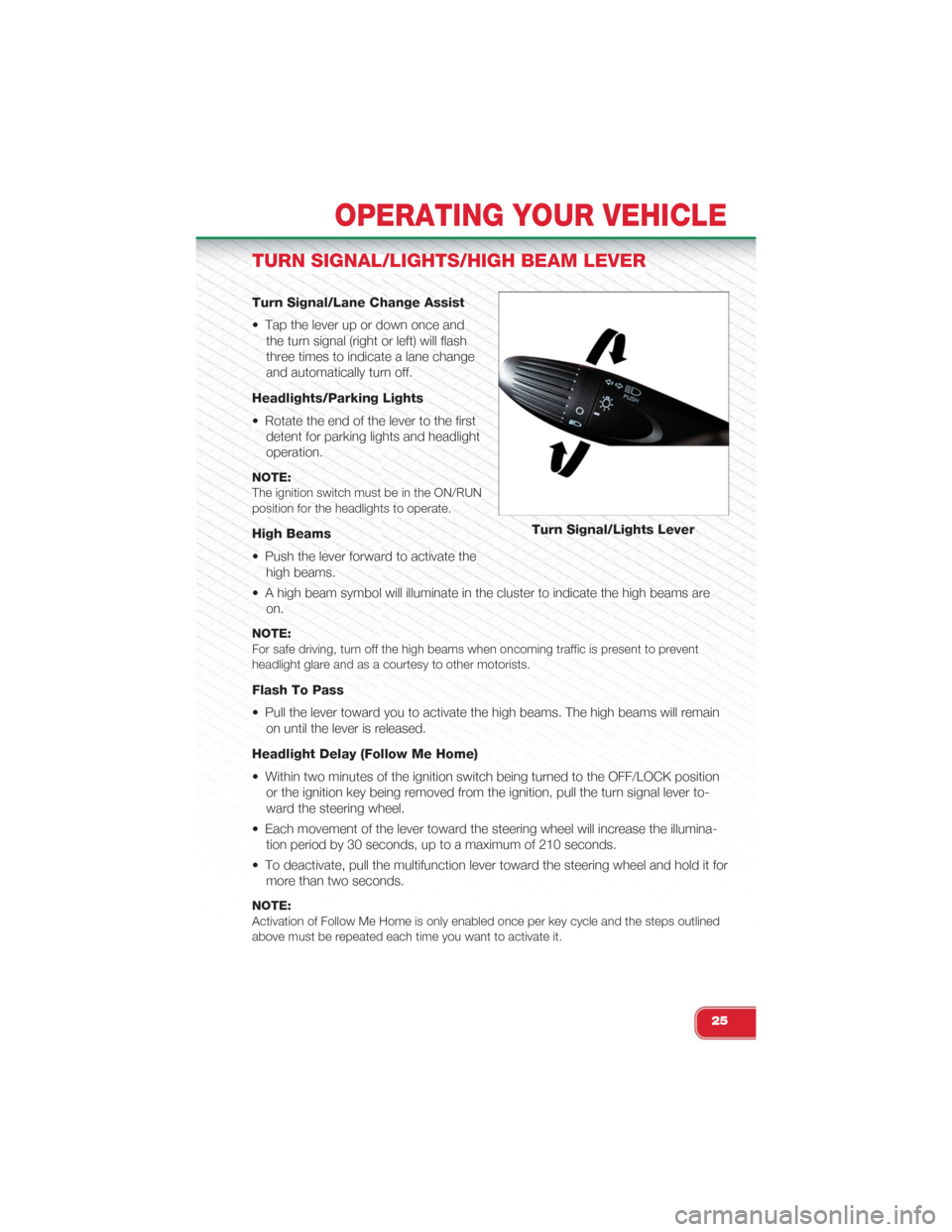
TURN SIGNAL/LIGHTS/HIGH BEAM LEVER
Turn Signal/Lane Change Assist
• Tap the lever up or down once and
the turn signal (right or left) will flash
three times to indicate a lane change
and automatically turn off.
Headlights/Parking Lights
• Rotate the end of the lever to the first
detent for parking lights and headlight
operation.
NOTE:The ignition switch must be in the ON/RUNposition for the headlights to operate.
High Beams
• Push the lever forward to activate the
high beams.
• A high beam symbol will illuminate in the cluster to indicate the high beams are
on.
NOTE:For safe driving, turn off the high beams when oncoming traffic is present to preventheadlight glare and as a courtesy to other motorists.
Flash To Pass
• Pull the lever toward you to activate the high beams. The high beams will remain
on until the lever is released.
Headlight Delay (Follow Me Home)
• Within two minutes of the ignition switch being turned to the OFF/LOCK position
or the ignition key being removed from the ignition, pull the turn signal lever to-
ward the steering wheel.
• Each movement of the lever toward the steering wheel will increase the illumina-
tion period by 30 seconds, up to a maximum of 210 seconds.
• To deactivate, pull the multifunction lever toward the steering wheel and hold it for
more than two seconds.
NOTE:Activation of Follow Me Home is only enabled once per key cycle and the steps outlinedabove must be repeated each time you want to activate it.
Turn Signal/Lights Lever
OPERATING YOUR VEHICLE
25
Page 28 of 108
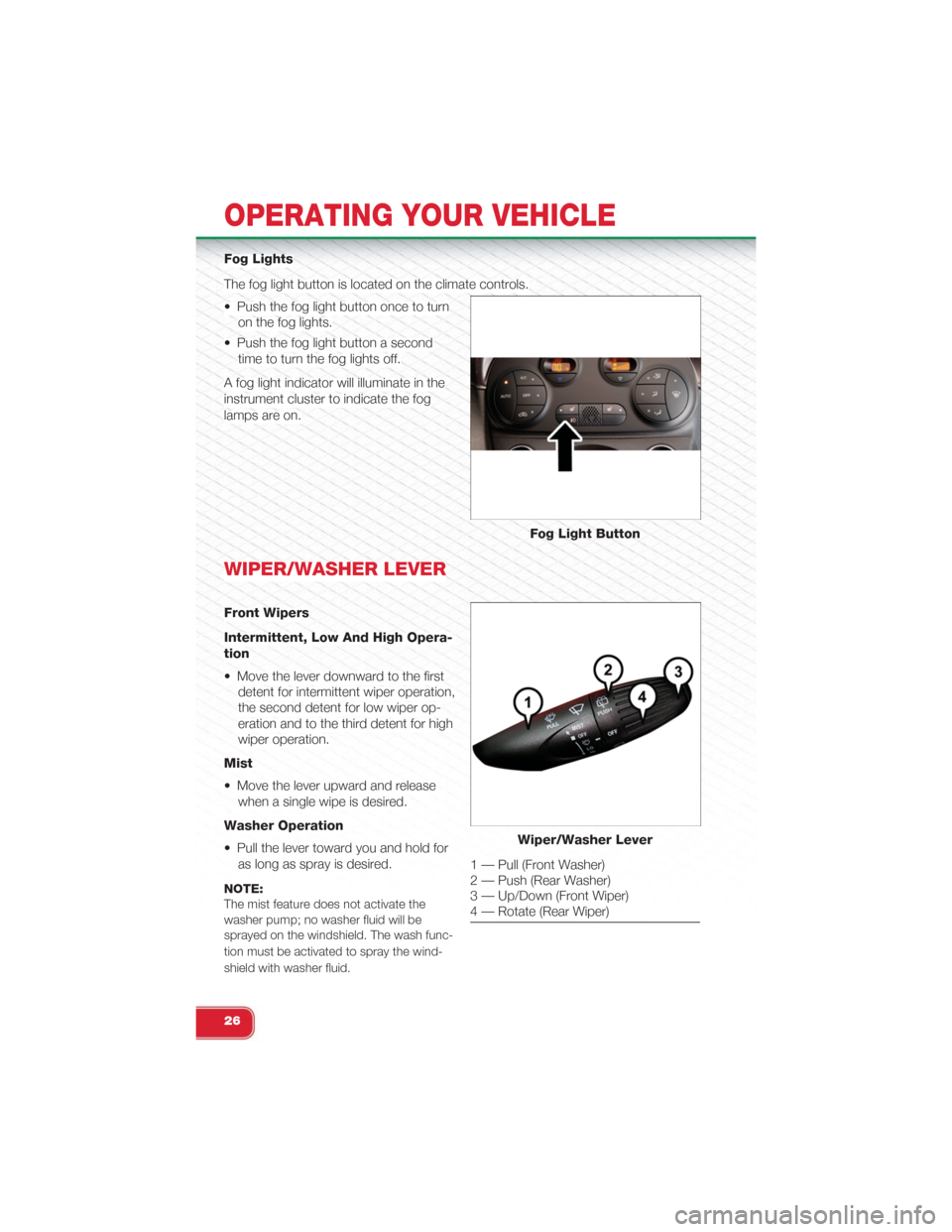
Fog Lights
The fog light button is located on the climate controls.
• Push the fog light button once to turn
on the fog lights.
• Push the fog light button a second
time to turn the fog lights off.
A fog light indicator will illuminate in the
instrument cluster to indicate the fog
lamps are on.
WIPER/WASHER LEVER
Front Wipers
Intermittent, Low And High Opera-
tion
• Move the lever downward to the first
detent for intermittent wiper operation,
the second detent for low wiper op-
eration and to the third detent for high
wiper operation.
Mist
• Move the lever upward and release
when a single wipe is desired.
Washer Operation
• Pull the lever toward you and hold for
as long as spray is desired.
NOTE:The mist feature does not activate thewasher pump; no washer fluid will besprayed on the windshield. The wash func-
tion must be activated to spray the wind-
shield with washer fluid.
Fog Light Button
Wiper/Washer Lever
1 — Pull (Front Washer)2 — Push (Rear Washer)3 — Up/Down (Front Wiper)4 — Rotate (Rear Wiper)
OPERATING YOUR VEHICLE
26
Page 29 of 108
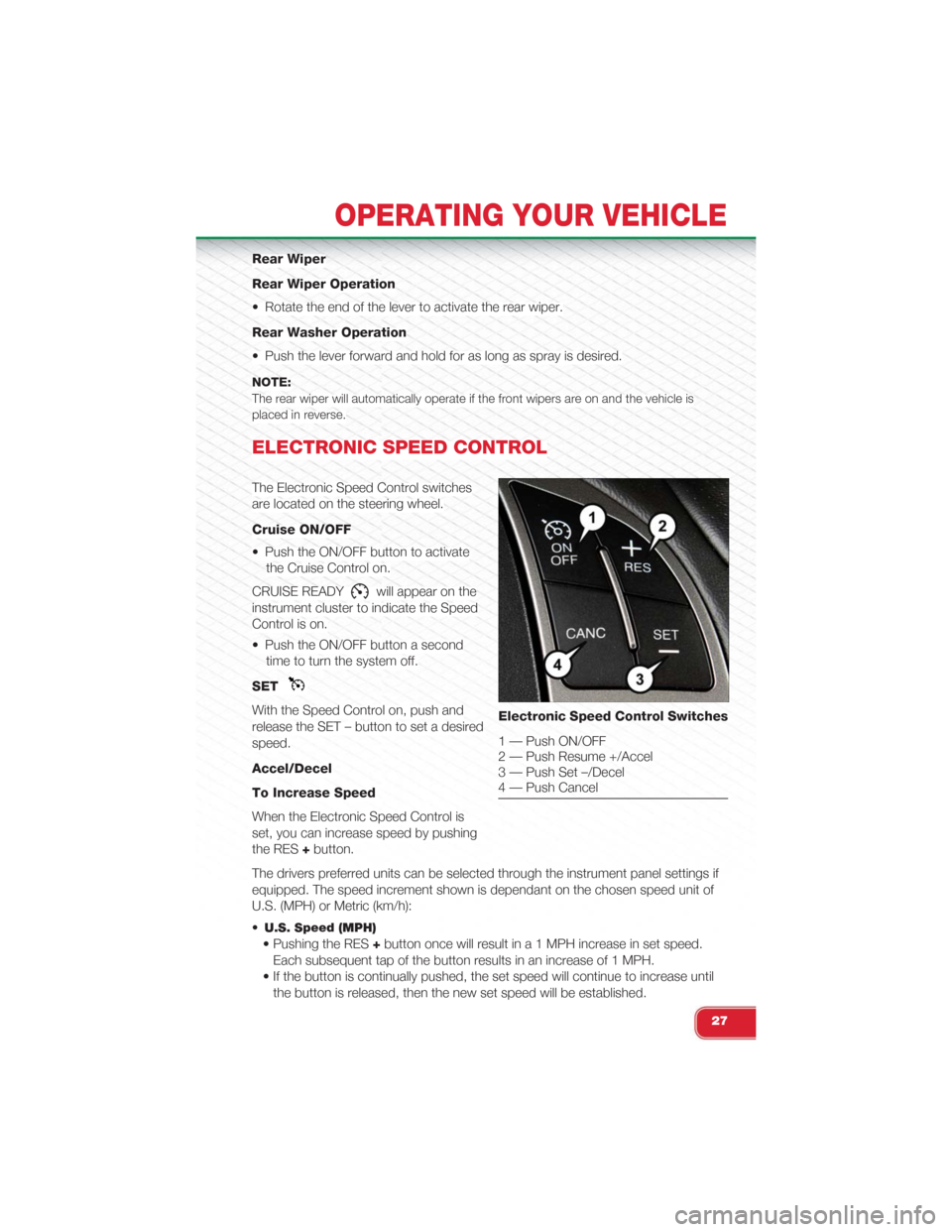
Rear Wiper
Rear Wiper Operation
• Rotate the end of the lever to activate the rear wiper.
Rear Washer Operation
• Push the lever forward and hold for as long as spray is desired.
NOTE:
The rear wiper will automatically operate if the front wipers are on and the vehicle is
placed in reverse.
ELECTRONIC SPEED CONTROL
The Electronic Speed Control switches
are located on the steering wheel.
Cruise ON/OFF
• Push the ON/OFF button to activate
the Cruise Control on.
CRUISE READYwill appear on the
instrument cluster to indicate the Speed
Control is on.
• Push the ON/OFF button a second
time to turn the system off.
SET
With the Speed Control on, push and
release the SET – button to set a desired
speed.
Accel/Decel
To Increase Speed
When the Electronic Speed Control is
set, you can increase speed by pushing
the RES+button.
The drivers preferred units can be selected through the instrument panel settings if
equipped. The speed increment shown is dependant on the chosen speed unit of
U.S. (MPH) or Metric (km/h):
• U.S. Speed (MPH)
• Pushing the RES+button once will result in a 1 MPH increase in set speed.
Each subsequent tap of the button results in an increase of 1 MPH.
• If the button is continually pushed, the set speed will continue to increase until
the button is released, then the new set speed will be established.
Electronic Speed Control Switches
1 — Push ON/OFF2 — Push Resume +/Accel3 — Push Set –/Decel4 — Push Cancel
OPERATING YOUR VEHICLE
27
Page 30 of 108
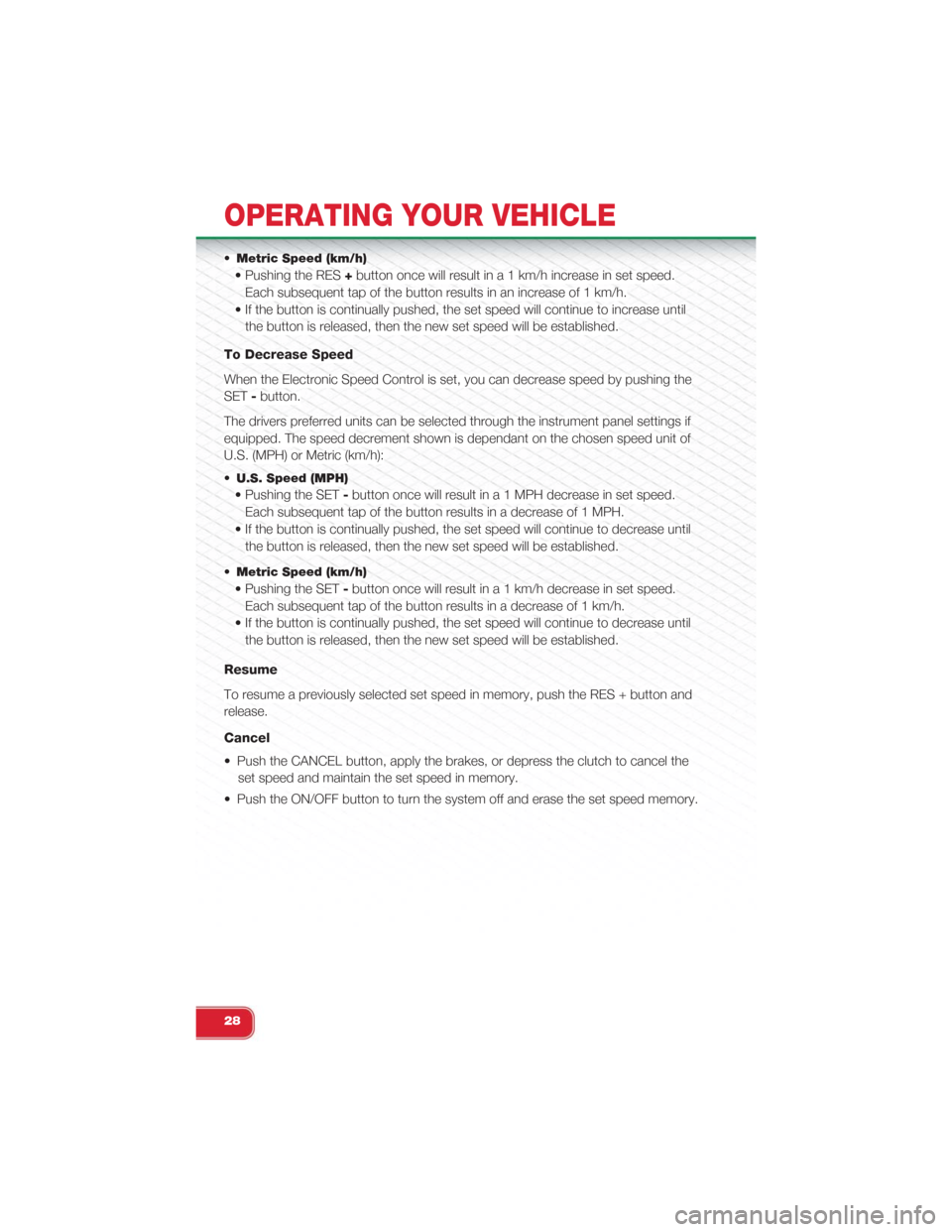
• Metric Speed (km/h)
• Pushing the RES+button once will result in a 1 km/h increase in set speed.
Each subsequent tap of the button results in an increase of 1 km/h.
• If the button is continually pushed, the set speed will continue to increase until
the button is released, then the new set speed will be established.
To Decrease Speed
When the Electronic Speed Control is set, you can decrease speed by pushing the
SET-button.
The drivers preferred units can be selected through the instrument panel settings if
equipped. The speed decrement shown is dependant on the chosen speed unit of
U.S. (MPH) or Metric (km/h):
• U.S. Speed (MPH)
• Pushing the SET-button once will result in a 1 MPH decrease in set speed.
Each subsequent tap of the button results in a decrease of 1 MPH.
• If the button is continually pushed, the set speed will continue to decrease until
the button is released, then the new set speed will be established.
• Metric Speed (km/h)
• Pushing the SET-button once will result in a 1 km/h decrease in set speed.
Each subsequent tap of the button results in a decrease of 1 km/h.
• If the button is continually pushed, the set speed will continue to decrease until
the button is released, then the new set speed will be established.
Resume
To resume a previously selected set speed in memory, push the RES + button and
release.
Cancel
• Push the CANCEL button, apply the brakes, or depress the clutch to cancel the
set speed and maintain the set speed in memory.
• Push the ON/OFF button to turn the system off and erase the set speed memory.
OPERATING YOUR VEHICLE
28